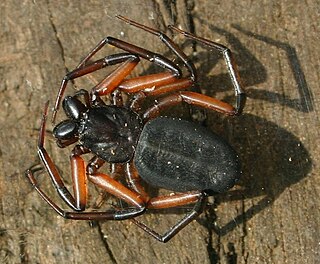
Linyphiidae, spiders commonly known as sheet weavers, or money spiders is a family of very small spiders comprising 4706 described species in 620 genera worldwide. This makes Linyphiidae the second largest family of spiders after the Salticidae. The family is poorly understood due to their small body size and wide distribution; new genera and species are still being discovered throughout the world. The newest such genus is Himalafurca from Nepal, formally described in April 2021 by Tanasevitch. Since it is so difficult to identify such tiny spiders, there are regular changes in taxonomy as species are combined or divided.
Pimoidae is a small family of araneomorph spiders first described by J. Wunderlich in 1986. As re-circumscribed in 2021, it is monophyletic, and contained 85 species in two genera. It is closely related to the Linyphiidae, and is sometimes treated as synonymous with that family.

Trochanteriidae is a family of spiders first described by Ferdinand Karsch in 1879 containing about 52 species in 6 genera. Most are endemic to Australia though Doliomalus and Trochanteria are from South America and Plator is from Asia. Platyoides species exist in southern and eastern Africa, Madagascar, and the Canary Islands with one species, P. walteri, introduced to Australia.
Synaphridae is a family of spiders with thirteen described species in three genera. It was first described as a subfamily of Anapidae, but it has since been raised to family status.

Cyatholipidae is a family of spiders first described by Eugène Simon in 1894. Most live in moist montane forest, though several species, including Scharffia rossi, live in dry savannah regions. They occur in Africa, including Madagascar, New Zealand and Australia, and one species in Jamaica. Most members of this family hang beneath sheet webs. Fossil species occur in the Eocene aged Bitterfield and Baltic Ambers, suggesting a wider geographic distribution in the past.

Archaeidae, also known as assassin spiders and pelican spiders, is a spider family with about ninety described species in five genera. It contains small spiders, ranging from 2 to 8 millimetres long, that prey exclusively on other spiders. They are unusual in that they have "necks", ranging from long and slender to short and thick. The name "pelican spider" refers to these elongated jaws and necks used to catch their prey. Living species of Archaeidae occur in South Africa, Madagascar and Australia, with the sister family Mecysmaucheniidae occurring in southern South America and New Zealand.

Rugathodes is a genus of comb-footed spiders that was first described by Allan Frost Archer in 1950. It is closely related to members of Theridion and Wamba.
Spermophorides is a genus of cellar spiders that was first described by J. Wunderlich in 1992.
Dippenaaria is a genus of African araneomorph spiders in the family Anapidae, containing the single species, Dippenaaria luxurians. It was first described by J. Wunderlich in 1995, and has only been found in South Africa. The genus was named in honour of South African arachnologist Ansie Dippenaar-Schoeman.
Penangodyna is a monotypic genus of Southeast Asian cribellate araneomorph spiders in the family Dictynidae containing the single species, Penangodyna tibialis. It was first described by J. Wunderlich in 1995, and has only been found in Malaysia.
Telemofila is a genus of long-legged cave spiders that was first described by J. Wunderlich in 1995. As of September 2019 it contains two species, found on Sumatra and New Caledonia: T. pecki and T. samosirensis.
Canariellanum is a genus of European dwarf spiders that was first described by J. Wunderlich in 1987.
Canariphantes is a genus of dwarf spiders that was first described by J. Wunderlich in 1992. It might be a junior synonym of Lepthyphantes.
Diplocentria is a genus of dwarf spiders that was first described by J. E. Hull in 1911.
Erigophantes is a monotypic genus of Indonesian dwarf spiders containing the single species, Erigophantes borneoensis. It was first described by J. Wunderlich in 1995, and has only been found on Borneo.
Heterolinyphia is a genus of Asian dwarf spiders that was first described by J. Wunderlich in 1973. As of May 2019 it contains only two species, both found in Bhutan, India, and Nepal: H. secunda and H. tarakotensis.
Heterotrichoncus is a monotypic genus of dwarf spiders containing the single species, Heterotrichoncus pusillus. It was first described by J. Wunderlich in 1970, and has only been found in Albania, Austria, Czech Republic, France, Russia, Slovakia, and Spain.
Oia is a genus of Asian dwarf spiders that was first described by J. Wunderlich in 1973.
Paragongylidiellum is a monotypic genus of Asian dwarf spiders containing the single species, Paragongylidiellum caliginosum. It was first described by J. Wunderlich in 1973, and has only been found in India and Nepal.

Bassaniodes is a genus of crab spiders that was first described by Reginald Innes Pocock in 1903.





